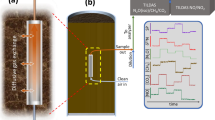Abstract
The goal of this project was to develop a method to measure the total gaseous mercury (TGM) concentrations in unsaturated soils. Existing methods did not allow for easy replication, were costly, and were more suited for other gases, such as CO2, that do not react with collection surfaces. To overcome these problems, we developed a method that simultaneously collects up to ten soil pore air samples. We used a single mass flow controller, one pump, and two banks of rotameters to draw soil air out of the ground at 25 smL min−1 onto gold-coated quartz traps. Analysis of the gold traps was performed with a Tekran 2500 CVAFS mercury detector. The system was field tested at the Piney Reservoir Ambient Air Monitoring Station in western Maryland. Our system was relatively precise and accurate. For example, replicate TGM concentrations differed by less than 25% and recovery of known amounts of mercury were greater than 95%. Field measurements showed that the maximum soil pore air TGM concentrations, between 3 and 4 ng m−3, occurred at the Oe–A soil horizon interface. At all other depths, the total mercury concentrations were lower than the ambient air concentrations of 1.8 ng m−3. We believe our new method can be used to precisely and accurately measure the TGM concentrations in unsaturated soils at multiple locations simultaneously.




Similar content being viewed by others
References
Bash, J. O. (2010). Description and initial simulation of a dynamic bidirectional air–surface exchange model for mercury in Community Multiscale Air Quality (CMAQ) model. Journal of Geophysical Research, 115, D06305. doi:10.1029/2009JD012834.
Brosset, C. (1987). The behavior of mercury in the physical environment. Water, Air, and Soil Pollution, 34(2), 145–166.
Carpi, A., Frei, A., Cocris, D., McCloskey, R., Contreras, E., & Ferguson, K. (2007). Analytical artifacts produced by a polycarbonate chamber compared to a Teflon chamber for measuring surface mercury fluxes. Analytical and Bioanalytical Chemistry, 388(2), 361–365.
Cohen, M., Artz, R., Draxler, R., Miller, P., Poissant, L., Niemi, D., et al. (2004). Modeling the atmospheric transport and deposition of mercury to the Great Lakes. Environmental Research, 95(3), 247–265.
Dastoor, A. P., & Larocque, Y. (2004). Global circulation of atmospheric mercury: a modelling study. Atmospheric Environment, 38(1), 147–161.
Engle, M. A., Gustin, M. S., Lindberg, S. E., Gertler, A. W., & Ariya, P. A. (2005). The influence of ozone on atmospheric emissions of gaseous elemental mercury and reactive gaseous mercury from substrates. Atmospheric Environment, 39(39), 7506–7517.
Ericksen, J. A., Gustin, M. S., Xin, M., Weisberg, P. J., & Fernandez, G. C. J. (2006). Air-soil exchange of mercury from background soils in the United States. Science of The Total Environment, 366(2), 851–863.
Fang, C., & Moncrieff, J. B. (1998). Simple and fast technique to measure CO2 profiles in soil. Soil Biology and Biochemistry, 30(14), 2107–2112.
Johnson, D. W., Benesch, J. A., Gustin, M. S., Schorran, D. S., Lindberg, S. E., & Coleman, J. S. (2003). Experimental evidence against diffusion control of Hg evasion from soils. The Science of the Total Environment, 304(1), 175–184.
Keeler, G., & Barres, J. (1999). Chapter IO-5: sampling and analysis for atmospheric mercury. In: Compendium of methods for the determination of inorganic compounds in ambient air, 34. EPA/625/R-96/010a. USEPA.
Kromer, E., Friedrich, G., & Wallner, P. (1981). Mercury and mercury compounds in surface air, soil gas, soils and rocks. Journal of Geochemical Exploration, 15(1), 51–62.
Moore, C., & Carpi, A. (2005). Mechanisms of the emission of mercury from soil: Role of UV radiation. Journal of Geophysical Research-Atmospheres, 110(D24302), 9.
Munthe, J., Wängberg, I., Pirrone, N., Iverfeldt, Å., Ferrara, R., Ebinghaus, R., et al. (2001). Intercomparison of methods for sampling and analysis of atmospheric mercury species. Atmospheric Environment, 35(17), 3007–3017. doi:10.1016/S1352-2310(01)00104-2.
Sigler, J. M., & Lee, X. (2006). Gaseous mercury in background forest soil in the northeastern United States. Journal of Geophysical Research-Biogeosciences, 111(G02007), 14.
USDA. (2010). Web Soil Survey. http://websoilsurvey.nrcs.usda.gov/app/WebSoilSurvey.aspx.
USEPA. (2002). Method 1631. Revision E: Mercury in water by oxidation, purge, and trap, and cold vapor atomic fluorescence spectrometry. EPA-821-R-02-019. internal-pdf://USEPA Method 1631-1256548612/USEPA Method 1631.pdf.
Wallschläger, D., Kock, H. H., Schroeder, W. H., Lindberg, S. E., Ebinghaus, R., & Wilken, R.-D. (2002). Estimating gaseous mercury emissions from contaminated floodplain soils to the atmosphere with simple field measurement techniques. Water, Air, and Soil Pollution, 135(1), 39–54. doi:10.1023/A:1014711831589.
Acknowledgments
We would like to thank John Sherwell, John Ondov, Andrew Heyes, and Eric Prestbo for their invaluable input and assistance with developing this technique. We appreciate Darrell Moore for his input and technical skills with a lathe. Finally, we would like to thank the graduate education committee at the Appalachian Laboratory for monetary support of this effort. This paper is contribution 4463 of the Appalachian Laboratory University of Maryland Center for Environmental Science.
Author information
Authors and Affiliations
Corresponding author
Additional information
An erratum to this article can be found at http://dx.doi.org/10.1007/s11270-011-0805-x
Rights and permissions
About this article
Cite this article
Moore, C.W., Castro, M.S. & Brooks, S.B. A Simple and Accurate Method to Measure Total Gaseous Mercury Concentrations in Unsaturated Soils. Water Air Soil Pollut 218, 3–9 (2011). https://doi.org/10.1007/s11270-010-0691-7
Received:
Accepted:
Published:
Issue Date:
DOI: https://doi.org/10.1007/s11270-010-0691-7




